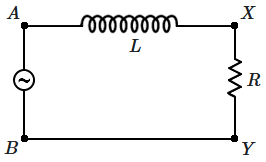| 1. | \(100~\text{mA}\) | 2. | \(200~\text{mA}\) |
| 3. | \(20~\text{mA}\) | 4. | \(10~\text{mA}\) |
Prefer Books for Question Practice? Get NEETprep's Unique MCQ Books with Online Audio/Video/Text Solutions via Telegram Bot
NEET MCQ Books for XIth & XIIth Physics, Chemistry & BiologyA \(15.0~\mathrm{\mu F}\) capacitor is connected to a \(220~\mathrm{V}\), \(50~\mathrm{Hz}\) source. If the frequency is doubled, what happens to the capacitive reactance and the current?
| 1. | the capacitive reactance is halved and the current is doubled. |
| 2. | the capacitive reactance is doubled and the current is halved. |
| 3. | the capacitive reactance remains the same and the current is doubled. |
| 4. | the current remains the same and the capacitive reactance is halved. |
Prefer Books for Question Practice? Get NEETprep's Unique MCQ Books with Online Audio/Video/Text Solutions via Telegram Bot
NEET MCQ Books for XIth & XIIth Physics, Chemistry & BiologyA resistor of \(200~\mathrm{\Omega}\) and a capacitor of \(15.0~\mu\text{F}\) are connected in series to a \(220~\text{V}\), \(50\) Hz AC source. The voltage (RMS) across the resistor and the capacitor are respectively:
1. \( 160.3 ~\text{V}, 160.3 ~\text{V} \)
2. \( 151 ~\text{V}, 151 ~\text{V} \)
3. \( 160.3 ~\text{V}, 151 ~\text{V} \)
4. \( 151 ~\text{V}, 160.3 ~\text{V}\)
Prefer Books for Question Practice? Get NEETprep's Unique MCQ Books with Online Audio/Video/Text Solutions via Telegram Bot
NEET MCQ Books for XIth & XIIth Physics, Chemistry & Biology
| 1. | \(60^\circ\) | 2. | \(90^\circ\) |
| 3. | \(30^\circ\) | 4. | \(45^\circ\) |
Prefer Books for Question Practice? Get NEETprep's Unique MCQ Books with Online Audio/Video/Text Solutions via Telegram Bot
NEET MCQ Books for XIth & XIIth Physics, Chemistry & Biology
| 1. | \(Z_1<Z_2\) | 2. | \(Z_1+Z_2=20~\Omega\) |
| 3. | \(Z_1=Z_2\) | 4. | \(Z_1>Z_2\) |
Prefer Books for Question Practice? Get NEETprep's Unique MCQ Books with Online Audio/Video/Text Solutions via Telegram Bot
NEET MCQ Books for XIth & XIIth Physics, Chemistry & Biology
| 1. | \(4~ \Omega\) | 2. | \(6~ \Omega\) |
| 3. | \(1~ \Omega\) | 4. | \(3~ \Omega\) |
Prefer Books for Question Practice? Get NEETprep's Unique MCQ Books with Online Audio/Video/Text Solutions via Telegram Bot
NEET MCQ Books for XIth & XIIth Physics, Chemistry & Biology| 1. | \(\nu=100 ~\text{Hz} ; ~\nu_0=\dfrac{100}{\pi} ~\text{Hz}\) |
| 2. | \(\nu_0=\nu=50~\text{Hz}\) |
| 3. | \(\nu_0=\nu=\dfrac{50}{\pi} ~\text{Hz}\) |
| 4. | \(\nu_{0}=\dfrac{50}{\pi}~ \text{Hz}, \nu=50 ~\text{Hz}\) |
Prefer Books for Question Practice? Get NEETprep's Unique MCQ Books with Online Audio/Video/Text Solutions via Telegram Bot
NEET MCQ Books for XIth & XIIth Physics, Chemistry & Biology| 1. | the impedance in the circuit is \(100~\Omega.\) |
| 2. | the resistance in the circuit is \(200~\Omega.\) |
| 3. | the power dissipated is \(484\) W. |
| 4. | all the above are true. |
Prefer Books for Question Practice? Get NEETprep's Unique MCQ Books with Online Audio/Video/Text Solutions via Telegram Bot
NEET MCQ Books for XIth & XIIth Physics, Chemistry & Biology
| 1. | depends on the ratio \(\frac{\omega L}{R}\) |
| 2. | depends on the quantity \(\sqrt{(\omega L)^2+R^2}\) |
| 3. | depends on \(L\) and \(R,\) but not on \(\omega\) |
| 4. | is independent of \(L,R,\omega\) |
Prefer Books for Question Practice? Get NEETprep's Unique MCQ Books with Online Audio/Video/Text Solutions via Telegram Bot
NEET MCQ Books for XIth & XIIth Physics, Chemistry & Biology1. \(\sqrt3:1\)
2. \(1:\sqrt3\)
3. \(3:1\)
4. \(2:1\)
Prefer Books for Question Practice? Get NEETprep's Unique MCQ Books with Online Audio/Video/Text Solutions via Telegram Bot
NEET MCQ Books for XIth & XIIth Physics, Chemistry & Biology